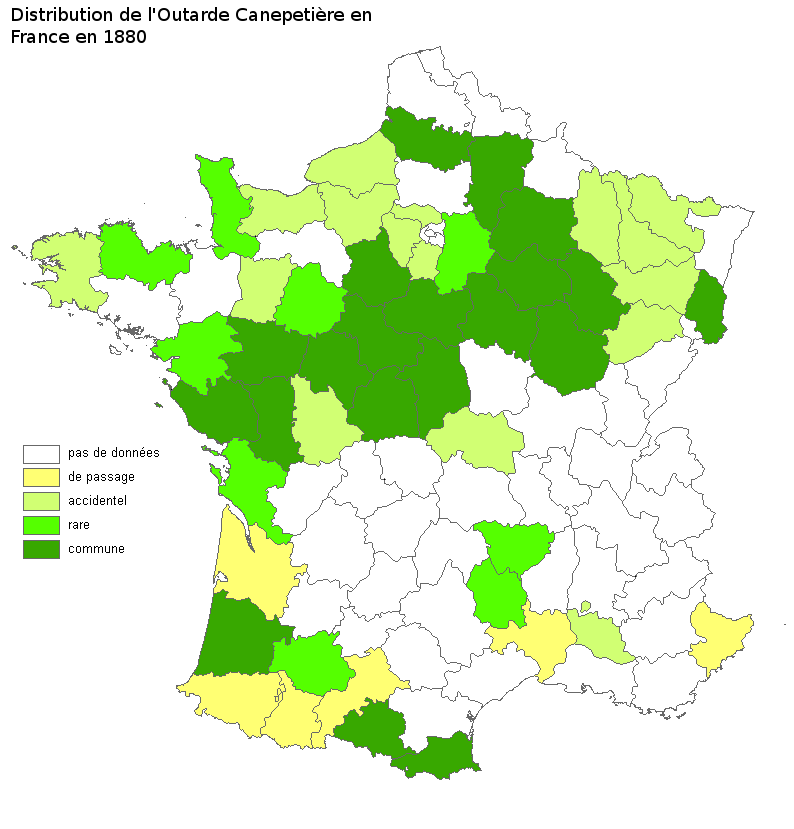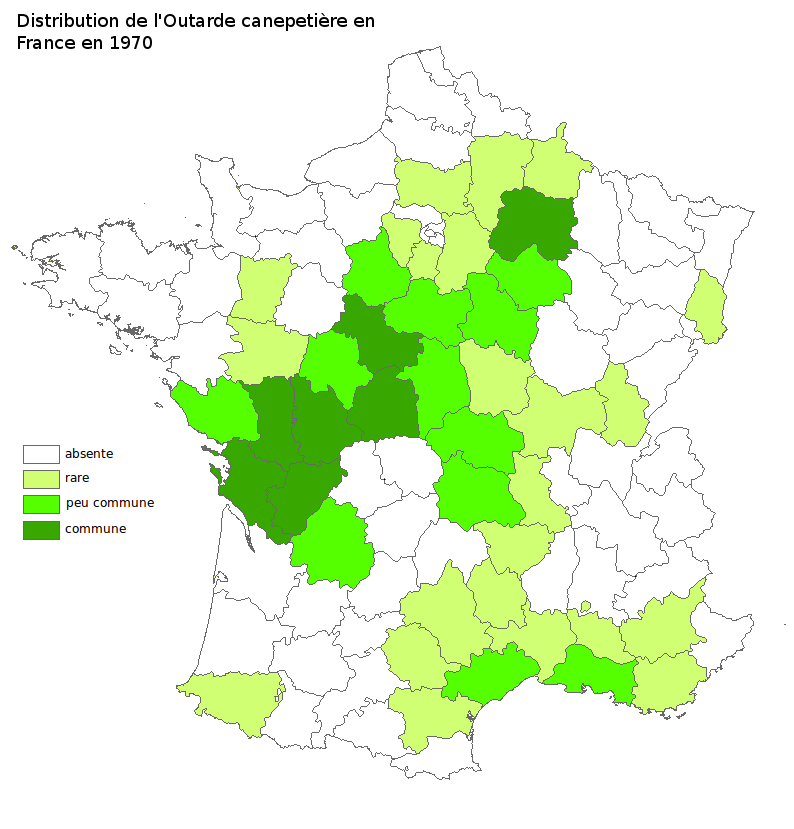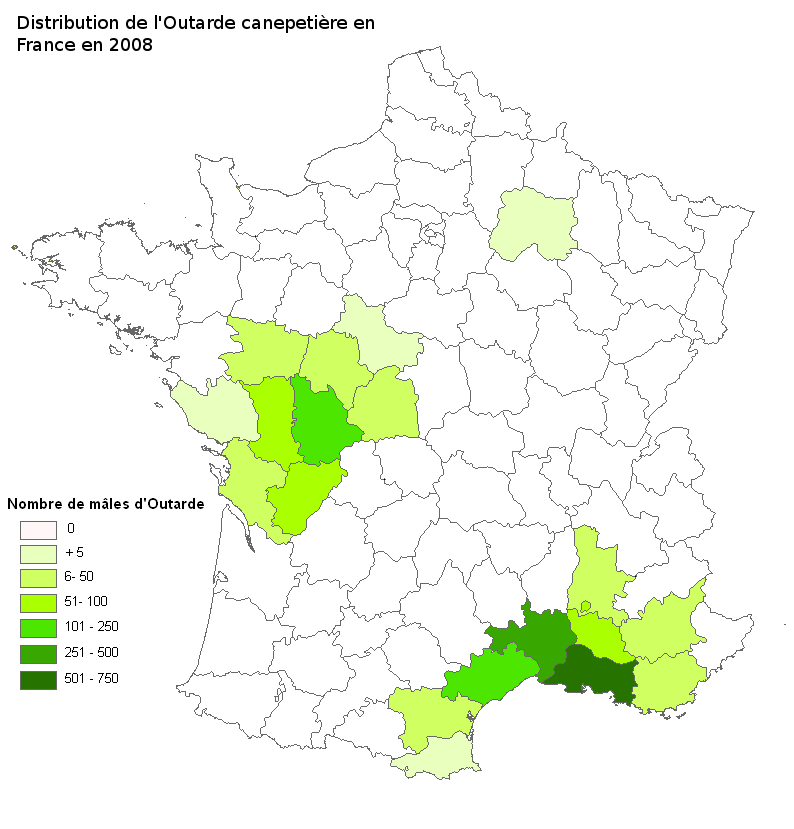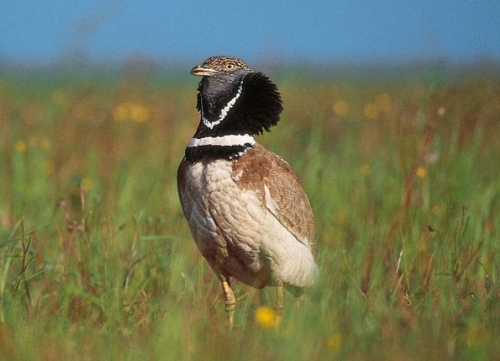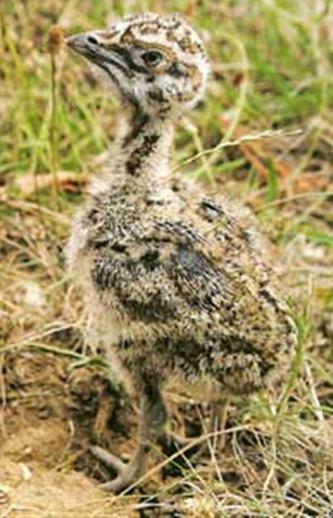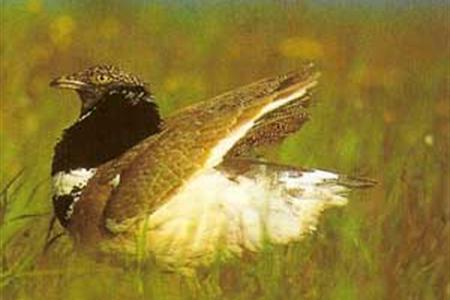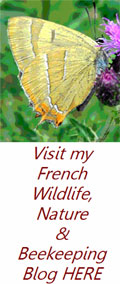Range: Historically the Little Bustard inhabited a vast range from Portugal to the extreme Northwest of China but after large population declines in the late 19th and 20th centuries it became extinct in many countries and today two distinct breeding populations remain, a western one with Portugal, Spain, France, Sardinia and the extreme Southeast of Italy; and an eastern one in South-eastern Russia and Kazakhstan.
In France the Little Bustard has disappeared completely from eight regions: Champagne-Ardennes, Alsace, Ile de France, Picardy, Burgundy, Franche-Comté, Aquitaine and Midi-Pyrenees. In these regions, the favourable habitat for the Little bustard no longer exists due to modern agricultural methods and the type of crops grown for food or industrial use. Alfalfa production (more than 70,000 ha in Champagne-Ardenne) alone is for the industrial production of dehydrated granules which requires frequent cuts in the plots, making them inhospitable for the Little bustard. Numerous scientific studies have shown that the main causes of decline of lowland birds is related to the intensification of agricultural systems and among others to the massive use of pesticides.
Changes in agricultural practices have resulted in the reduction of food resources and nesting sites which are limiting factors for lowland birds. The Little Bustard, far from being an exception, has seen its numbers tumble drastically in the cultivated plains of Europe. On the Atlantic coast, the favorable Little bustard habitat, based on mixed farming systems, exists only on certain sites in Poitou-Charentes, Pays de la Loire and Centre. This habitat is steadily declining due to loss of fallow and the concomitant development of intensive farming, grain and biofuels. The decline of Little Bustard populations in cereal plains of Central and West France is the result of profound changes in agricultural practices that started in the 60's and whose impact has accelerated through the 80's and 90's. Only the Mediterranean regions have sufficient good habitat left, particularly Crau. In Languedoc-Roussillon and Provence the habitat stability is not guaranteed, mainly because of the development of agriculture and increasing urbanization. Everywhere in France, the urbanization of agricultural land and infrastructure construction gradually erodes the available habitat for Little Bustard.
Click maps to expand.
About the Little Bustard:
The Little Bustard is quite a large bird at 44 cm, (that’s about Crow size), rather shy with a tendency to crouch down and lie flat in ground cover when disturbed. It is fully migratory in the west of France, (principally Poitou-Charentes), with the majority of the birds over wintering in Spain. A non migratory population is in La Crau, Var, (Provence-Alpes-Côte d'Azur).
They have a method of reproduction that is extremely rare in the bird world and when in April the birds arrive at the breeding sites the males form small groups where they begin their extraordinary mating rituals, leaping up and down hammering the ground with wings extended, neck feathers fluffed out in a large ruff while at the same time making their distinctive chant, quite a spectacular display! The females visit the males display area to choose a male to breed with, this makes the males even more excited; then the female makes her choice and coupling takes place – this is all she will have to do with the male, she then departs, prepares her own “nest” site, which is a small hollow in the ground, incubates and raises her chicks with no further assistance or contact with the male.
Reproduction and breeding in captivity - the migratory Little Bustard building program.
Registered with the national recovery plan and the national action plan, the building program for the migratory populations of Little Bustards began under the second LIFE program involving various organisations and structures. A first breeding center for the Little Bustard was created in 2005 in the Deux Sevres to breed in captivity followed by releasing them on the plains of West Central France. The aim is to prevent the extinction of the Little Bustard in the cereal plains of Poitou-Charentes by bolstering the population level with the introduction of captive-bred birds. Between 1978 and 2000, the number of Little Bustard in the Central and West France fell from 6800 to 400 "singing males", a decrease of 94% of the population in 22 years.The migratory Little Bustard survives in only three areas, Poitou-Charentes (400 males), Centre (40-50 males) and Pays de la Loire (20 males).
At the end of the LIFE program in 2009, the breeding center was moved. It was replaced by Centre d’Elevage pour la Préservation des Oiseaux de Plaine (the Breeding Centre for the Preservation of Birds of the Plain) (POPRC), located at Virollet, Deux Sevres on a property belonging to the Conseil Général 79.
Le Centre d’Etudes Biologiques de Chizé (CEBC/CNRS) and le Parc de la Haute Touche managed by le Muséum National d’Histoire Naturelle (MNHN) are parteners in this action and provide eggs produced in captivity in their own farms
Bustard eggs incubated at POPRC can also come from the natural environment when broods are saved during field cutting. From hatching to 15 days old the chicks are placed in heated boxes and receive between 5 and 10 meals per day as they grow. The diet has been gradually developed since 1996 by CEBC and the Sainte-Blandine Centre. This diet mainly based on proteins is complemented by plants. Chicks require constant care throughout the day. Following on the young Bustards are transferred to outdoor aviaries, then when they reach adult size they are placed in pre-release aviaries installed on the plain before releasing them to migrate to Spain alongside their wild companions.
The situation with the breeding and protection program is far from settled or guaranteed with funding issues and a continual struggle to reconcile the demands to use all the land for economic purposes, (agriculture), against providing protection for endangered native species or indeed any native species that continue to decline resulting from human activity.
RED LISTED AS NEAR THREATENED.
This species is listed as Near Threatened because it is experiencing a moderately rapid overall population decline, driven by rapid declines in the west of its range owing mainly to degradation and loss of habitat as well as low-level hunting pressure. Recent increases in the east of its range are not quantified, and require further study. Such data may have implications for the overall population trend and listing of the species.
Mentioned above was the term "singing males".Counting singing males in spring - early summer is one method of population measurement, the other is for organised teams of people to go to known pre-migration assembly areas in September / October and count all the Bustards that can be seen. Towards the end of the video in the link the male Bustard throws its head back and makes almost a long click or grunt sound - this is the sound to listen out for in the field to locate males when not visible.

